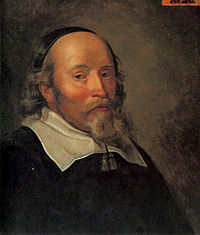Walloon immigration to Sweden
This article includes a list of general references, but it lacks sufficient corresponding inline citations. (May 2018) |
The history of Walloon immigration to Sweden begins with industrialists (Willem de Besche; 1573-1629) and Louis De Geer (1587–1652), known as "the father of the Swedish steel industry". Five to ten thousand Walloons emigrated to Sweden, mainly working in the steel industry. During the 1920s, trade unions presented them to Swedish workers as mythical models.
History[]

On 28 January 1613, the King of Sweden put an end to the Kalmar War and was forced to make an expensive peace with the King of Denmark. He had to borrow money to pay his debts. In 1616 he approached the Dutch, offering the abundant iron mines of Sweden as collateral. Louis de Geer, from Liège, contacted the Besche brothers, one of whom, Guillaume de Bèche, had been established in Sweden since 1595 and was exploiting the iron works of Nyköping and Finspång with Walloons exiled from the Low Countries for religious reasons.
From 1620, between 5,000 and 10,000 Walloons emigrated to Sweden for economic and religious reasons. The Swedes were amazed by their technical knowhow, which helped them to make great progress in the steel industry. Between 1620 and 1650, Swedish steel exports trebled, reaching 17,500 tons a year, in particular for the English navy. The Walloons’ lifestyle was also ahead of Sweden’s, particularly with regard to hygiene. They remained separate from the Swedish population for a long time, jealously keeping their technical secrets until the end of the 18th century.
Legacy and recognition[]
Walloon immigrants were behind Swedish metallurgy from the 17th century onwards and the Walloon language remained spoken in some areas until the 19th century. The impact of Walloon immigration in Sweden was lasting, coming to be embodied in the myth of the Walloon trade-union hero, which corresponds neither to the historic reality of the 17th and 18th centuries nor to the reality of the 1920s in Sweden.
Around 1920, at a time when the Walloon presence was fading, the newspaper of the Swedish metalworkers union gave birth to the myth of the Walloon worker, who was both strong and endowed with a deep class consciousness transposed into the past. This newspaper, Metallarbetaren, printed these surprising lines (June 3, 1922):
Walloons are stronger than the Flemings (the Dutch-speaking inhabitants of Belgium), thinner, more nervous, healthier, and they live longer. Their skill and their professionalism are superior to those of the Flemish. They exceed the French in tenacity and enthusiasm - qualities which favoured their immigration in Sweden. But their passionate rashness makes them look like the French people.
Thus was invented the myth of the Walloon capable of trade-union action, in particular by the strike, presented as a model to the Swedes. Anders Florén and Math Isacson, in De fer et de feu, l’émigration wallonne vers la Suède (2003), write: "there doubtless existed, in these difficult times of crisis, a strong need for models, and Walloons offered an ideal embodiment of the values which the labor union of the metallurgists intended to promote."[1]
References[]
- ^ Anders Florén and Maths Isacson (2003), De fer et de feu, l’émigration wallonne vers la Suède, Louvain, pp. 271-286 (chapter "Le Wallon et les forges dans le discours politique suédois d’entre-deux-guerres").
Sources[]
- Stanislas Bormans, "Les Wallons en Suède", Bulletin de l'Institut archéologique liégeois, vol. XXI, 1888, pp. 127-135 (online)
- Luc Courtois and Jean Pirotte (eds.), De fer et de feu, l’émigration wallonne vers la Suède, Fondation wallonne, Louvain, 2003.
- L. Courtois and C. Sappia (eds.), De Fer et de feu. L'émigration wallonne vers la Suède. Histoire et mémoire (XVIIe-XXIe siècles). Exhibition in the Walloon Parliament, Namur, 19-29 Feb. 2008 (Publications de la Fondation Wallonne P.-M. et J.-F. Humblet. Série Études et documents, vol. V), Louvain-la-Neuve, 2008.
- E.M. Braekman, Le protestantisme belge au XVIIème siècle, Collection Terres Protestantes, Éditions La Cause, Carrières-sous-Poissy, 2001.
- Immigration to Sweden
- Walloon diaspora
- Swedish people of Belgian descent